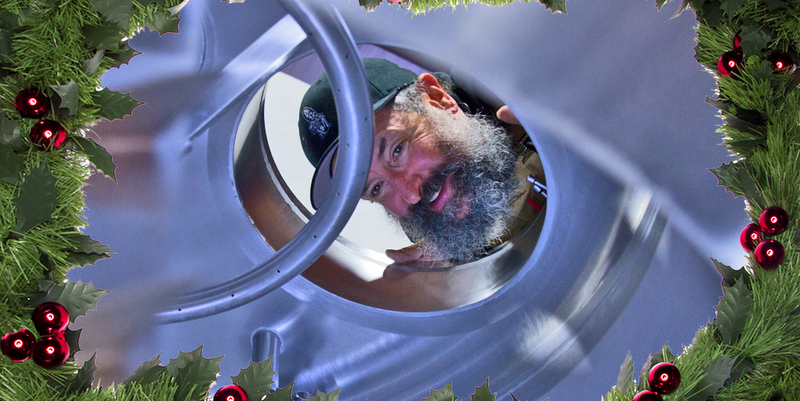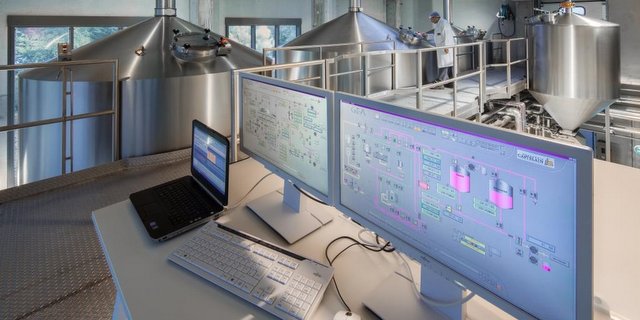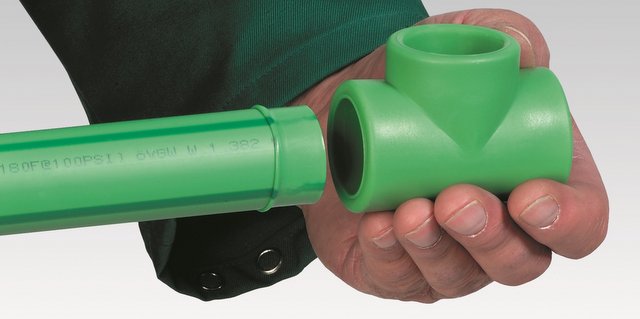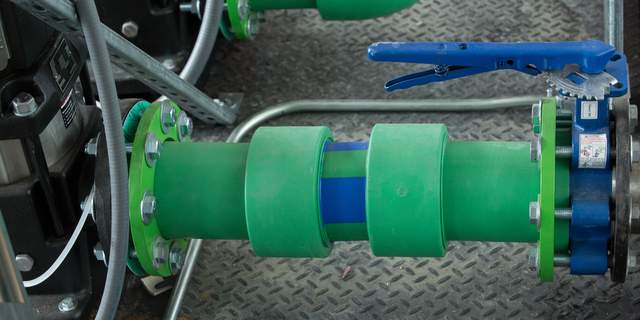Simple changes can add up to a huge impact

Julia Person, sustainability manager,
Redhook Brewery (Woodinville, Wash.; Portsmouth, N.H.)
At Redhook Brewery, we have a direct line of sight to the impact we can make — on our local community and environment — through our sustainability efforts. As one of the earliest pioneers in craft brewing, we’ve learned that simple improvements within our day-to-day operations add up to significant resource and dollar savings over the long-term. For example, when changing out conveyors in the bottle hall, we converted to a dry bottling line, which has resulted in 50,000 gallons of water [and sewer costs] saved annually. The switch also earned us a Safer Chemistry Champion award from the Washington Department of Ecology.
In our Portsmouth brewery, we are embarking on an innovative project to harness bio-power from our existing wastewater treatment plant. Breweries are ripe for closed-loop processes such as this, and we encourage all breweries to consider capturing waste heat, returning condensate, reusing rinse water and maximizing heat exchangers. And don’t forget about the nutrient-rich byproducts [yeast, spent grain, trub and any waste beer] that can be harnessed for power or feed for local cattle.
Controlling the boil

Gregg Norris, sales engineer,
GEA Brewery Systems (Kitzingen, Germany)
To say eco-friendly brewing is a priority for craft brewers is a monumental understatement. It’s simply synonymous with the revolution. At GEA, our design philosophy is no different and products like our COMPACT-STAR brewhouse has many features to prove it. Let’s take the wort kettle and internal boiler. By boiling smart, you can reduce boiling times and lower energy consumption by over 50 percent. Two phase boiling, like with our JETSTAR, enables the brewer to create a gentler, more homogeneous heat treatment of the wort for the majority of the boil time. “Simmer” boiling improves trub separation and increases overall wort quality while using much less steam. A win, win, win.
Only for a shorter period is the evaporative boiling phase required for the necessary removal of unwanted volatiles. We utilize a unique thermo-siphon design with a multilevel wort spreader to do this quickly and effectively. In addition, recovered heat from the kettle vapor stack can be stored and reused for wort heating, which further reduces the brewery’s carbon footprint and gas emissions. Other features to look for include lautering to extract yields exceeding 98 percent. By capturing so much of the extract, sewer BOD levels are almost nothing and you make more beer with less malt.
Furthermore, a balanced wort cooling system is instrumental in energy savings. By making up just the right amount of hot brewing water as the wort is cooled and transferred to the cellar, virtually no steam is required! Because of this, water usage in a COMPACT-STAR brewhouse has been seen as low as 1.3 hectoliters for every hectoliter of wort produced. Again, designed to use only those natural resources that are necessary.
From solar panels to packaging

Dean Coffey, brewmaster and co-founder,
Ale Asylum (Madison, Wis.)
No matter the size of your operation, you can implement sustainable brewery practices that can lower your carbon footprint. When we first opened in 2006, we practiced water conservation efforts, had our spent grain picked up by area farmers and installed an energy efficient calandria to heat the wort in our brew kettle in place of direct flame or a steam jacket. We continue these practices to present day.
In 2011, we underwent a large expansion that involved building a new brewery from the ground up. One of the major questions I continuously asked myself during this build out was, “How can I increase our conservation efforts as we expand and production increases?” The first idea we had involved capturing the energy given off in fermentation to heat the water used in our tasting room.
Another idea we had was to harness the frigid winter air to refrigerate our 3,500-square-foot walk-in cooler. From there, we purchased the single most efficient boiler offered on the market. Over the years, we have been able to implement additional sustainable methods that have an increased financial requirements but ultimately enhanced our bottom line over time.
Our most recent installation is a rooftop photovoltaic solar system that will reduce greenhouse emissions equal to that of an average passenger vehicle driving 7.13 million miles. This May, we started offering four of our brands in aluminum cans in cardboard wrap, which is the most earth-friendly way to package beer. Whether you’re a commercial brewer or homebrewer, no sustainable brewing practice is too small because a little will go a long way.
Ensure your arteries are as eco-friendly as possible

Barry Campbell, vice president of advertising and media relations,
Aquatherm (Medina, Ohio)
When considering the ideal attributes for a craft brewing operation’s piping infrastructure, functionality is obviously paramount. However, if you’re focused on running an environmentally friendly brewing operation, other important attributes are as well: longevity, durability, chemical inertness and a low environmental impact of production. Piping systems are like a brewing operation’s arteries, and your operation requires solid arteries delivering domestic water, compressed air, glycol from the chillers to the vats, product to the canning/bottling operation, compressed air, and heating/cooling to the facility. If these (and many other) pipelines aren’t operating efficiently, the beer will suffer.
So, it’s not surprising that in an industry where eco-friendly innovation runs rampant and successful technologies rapidly spread via word of mouth, brewers from Vancouver to Florida have come up with proven — and unique — ways of using polypropylene [PP] pipe systems as their arteries. Polypropylene has been around for several decades, but only recently has Aquatherm’s polypropylene-random [PP-R] been approved for domestic water, HVAC, compressed air and even food safe applications, among others.
Studies have shown that from raw material to installed end-product, PP piping systems require less energy to produce than comparable alternatives [no mining, raw PP is a byproduct of petroleum processing, thus making use of a readily available material]. Polypropylene is among the most environmentally friendly pressure-piping system available. The piping material is corrosion resistant, nontoxic, lead-free, fully recyclable, chemically inert, non-leaching and possesses a natural R-value of 1 or more depending on pipe size and wall thickness. The heat fusion method used to connect pipe and fitting results in a virtually leak-free bond that is performed without open flames, glues or the emission of VOCs.
Onsite, distributed water management systems

Matt Silver, CEO,
Cambrian Innovation (San Jose, Calif.)
Brewing is a water-intensive art. On average, breweries consume four to five gallons of water for each gallon of beer produced. That adds up to a lot of wastewater. Craft breweries often start up in local, small communities and rapidly outstrip the local treatment capacity as they grow. Cities are forced to hike up fees for wastewater discharge or, in some cases, to refuse the water, making breweries truck it elsewhere. On top of this, many breweries are located where water stress and scarcity limits production. Fees, regulations, scarcity and a desire to reduce their environmental impact all drive breweries to search for innovative solutions to their water challenges. Onsite, distributed wastewater treatment systems are that solution.
The secret to economic onsite water treatment is energy extraction. Some brewers may not realize that the high organic loading in brewery wastewater can actually be converted into biogas. Cambrian Innovation’s EcoVolt Reactor, for example, uses advanced biotechnology to recover clean electricity and clean heat from wastewater while cleaning up the water. The EcoVolt MBR is a final polishing step that allows for onsite water reuse. A complete EcoVolt Solution at Lagunitas Brewing Co. is generating 15 percent of the brewery’s electricity demand, 7 percent of the heat demand and cutting water consumption by 40 percent by enabling water reuse in non-beer processes. This project reduces Lagunitas’ carbon dioxide emissions by 1,600 metric tons, equivalent to planting 1,580 trees every year. Brewers looking for a sustainable and economic solution for water management should consider how a simple, distributed system on their site could cut their water and energy consumption and costs while increasing their production capacity.
Turn it off (or down)

Julia Person, sustainability manager,
Kona Brewing Co. (Kona, Hawaii)
On the Hawaiian Islands, it’s extremely important to be active stewards of our precious natural resources. At Kona Brewing Co., shrinking that carbon footprint often comes down to turning off or turning down anything we can. We use solar tubes to deliver natural light and occupancy sensors to ensure lights are only on when necessary. Compressed air is equipped with solenoid valves so it’s not being wasted when equipment is off. In the brewhouse, working with our QA folks to decrease boil time for even a few minutes results in energy savings batch after batch. The fans on our refrigeration system for cold storage are set to turn off when the area reaches the correct temperature. Our pub uses low-flow faucets and follows the tenets of the Green Restaurant Association certification to minimize our resource usage. It doesn’t always have to be big, sexy solar panels — we have those too, 990 to be exact, which generate close to 50 percent of our energy needs — to make an impact. Sometimes, simply remembering the old adage to “turn it off when you’re not using it” is enough to help a brewery operate in a more efficient and sustainable manner.
The forecasting and framework of eco-brewing

Ross Ackermann, founder & COO,
GP Analytics LLC (Seattle)
Eco-friendly brewing and operations are helped greatly by better analytics and accurate forecasting. The clarity data can give each department of a brewery will maximize efficient production, shipping and purchasing practices. As forecast and supply chain experts, we understand the demand at the consumer level for individual brands and SKUs. This knowledge can then build accurate production schedules [maximizing brewery efficiencies], shipping schedules [building full loads and minimizing unneeded travel], and help with raw material purchasing [buying only the ingredients or equipment necessary at the right time]. As an added benefit, forecasting can also minimize the amount of product that might [in the case of going out of code] need to be dumped and similarly minimize the chances of sending too little product and running out in the market.
Analytics have the ability to better utilize the tools you already have and better understand what your brewery will need to keep producing great beer into the future. As long-time professionals in the beer industry, we always recommend breweries invest in technologies that will return value to their business. With the right analytics, breweries can track and manage their input and output to see where they could be more efficient or how to better supply their distributors [and ultimately the consumer] with the beer they want. All breweries, especially eco-friendly ones, should value forecasting as the best barometer for measuring sustainability.





Want your brewery to be eco-friendly? Check out these tips from the pros! http://t.co/NwXKAWXK6c @craftbrewingbiz
Eco-friendly brewing tips from top craft brewing professionals #sustainability #craftbeer http://t.co/jJkd9v5zLr via @craftbrewingbiz
RT @VictoryBeer: Eco-friendly brewing tips from top craft brewers – http://t.co/g3LuGCpeC0 @CraftBrewingBiz #TasteVictory ^MB http://t.co/4…
RT @VictoryBeer: Eco-friendly brewing tips from top craft brewers – http://t.co/g3LuGCpeC0 @CraftBrewingBiz #TasteVictory ^MB http://t.co/4…
Eco-friendly brewing tips from top craft brewing professionals. Great insight from @craftbrewingbiz http://t.co/sdIFsNfSuG
RT @IR_So_Gulf: Craft brew pros and #IR’s Greg Jakobek share eco-friendly brewing tips http://t.co/i2bnxSNZ15 via @craftbrewingbiz
Piping tips for Brewers: http://t.co/SCWgYVEdXz
Craft brew pros and #IR’s Greg Jakobek share eco-friendly brewing tips http://t.co/i2bnxSNZ15 via @craftbrewingbiz
RT @VictoryBeer: Eco-friendly brewing tips from top craft brewers – http://t.co/g3LuGCpeC0 @CraftBrewingBiz #TasteVictory ^MB http://t.co/4…
RT @VictoryBeer: Eco-friendly brewing tips from top craft brewers – http://t.co/g3LuGCpeC0 @CraftBrewingBiz #TasteVictory ^MB http://t.co/4…
RT @VictoryBeer: Eco-friendly brewing tips from top craft brewers – http://t.co/g3LuGCpeC0 @CraftBrewingBiz #TasteVictory ^MB http://t.co/4…
@VictoryBeer @CraftBrewingBiz Great location for a photo, lol. http://t.co/tDiNjp1rqx
RT @VictoryBeer: Eco-friendly brewing tips from top craft brewers – http://t.co/g3LuGCpeC0 @CraftBrewingBiz #TasteVictory ^MB http://t.co/4…
RT @VictoryBeer: Eco-friendly brewing tips from top craft brewers – http://t.co/g3LuGCpeC0 @CraftBrewingBiz #TasteVictory ^MB http://t.co/4…
RT @VictoryBeer: Eco-friendly brewing tips from top craft brewers – http://t.co/g3LuGCpeC0 @CraftBrewingBiz #TasteVictory ^MB http://t.co/4…
RT @VictoryBeer: Eco-friendly brewing tips from top craft brewers – http://t.co/g3LuGCpeC0 @CraftBrewingBiz #TasteVictory ^MB http://t.co/4…
RT @VictoryBeer: Eco-friendly brewing tips from top craft brewers – http://t.co/g3LuGCpeC0 @CraftBrewingBiz #TasteVictory ^MB http://t.co/4…
RT @VictoryBeer: Eco-friendly brewing tips from top craft brewers – http://t.co/g3LuGCpeC0 @CraftBrewingBiz #TasteVictory ^MB http://t.co/4…
RT @VictoryBeer: Eco-friendly brewing tips from top craft brewers – http://t.co/g3LuGCpeC0 @CraftBrewingBiz #TasteVictory ^MB http://t.co/4…
RT @VictoryBeer: Eco-friendly brewing tips from top craft brewers – http://t.co/g3LuGCpeC0 @CraftBrewingBiz #TasteVictory ^MB http://t.co/4…
Eco-friendly brewing tips from top craft brewers – http://t.co/g3LuGCpeC0 @CraftBrewingBiz #TasteVictory ^MB http://t.co/4ksOWzQ0vA
RT @VictoryBeer: Eco-friendly brewing tips from top craft brewing professionals – http://t.co/g3LuGCpeC0 @CraftBrewingBiz #victory^MB http:…
RT @CraftBrewingBiz: Eco-friendly brewing tips from top craft brewing professionals. Thanks a ton @VictoryBeer http://t.co/LeI8psrKkk http:…
RT @HughesBrews: Eco-friendly brewing tips from top craft brewing professionals http://t.co/FNju8JjQv2 via @craftbrewingbiz #craftbeer
RT @HughesBrews: Eco-friendly brewing tips from top craft brewing professionals http://t.co/FNju8JjQv2 via @craftbrewingbiz #craftbeer
RT @HughesBrews: Eco-friendly brewing tips from top craft brewing professionals http://t.co/FNju8JjQv2 via @craftbrewingbiz #craftbeer
Interesting read. https://t.co/MHaofy20RR
Craft breweries finding ways to be tasty with less waste-y http://t.co/8L8HmLFXj4 Go Craft Brew Alliance, @WidmerBrothers @Redhook_Brewery
Eco-friendly brewing tips from top craft brewing professionals http://t.co/FNju8JjQv2 via @craftbrewingbiz #craftbeer
RT @Ale_Asylum: Brewmaster Dean contributed to a feature blog on eco-friendly brewing for @CraftBrewingBiz. Cheers to sustainability! http:…
RT @Ale_Asylum: Brewmaster Dean contributed to a feature blog on eco-friendly brewing for @CraftBrewingBiz. Cheers to sustainability! http:…
RT @Ale_Asylum: Brewmaster Dean contributed to a feature blog on eco-friendly brewing for @CraftBrewingBiz. Cheers to sustainability! http:…
Brewmaster Dean contributed to a feature blog on eco-friendly brewing for @CraftBrewingBiz. Cheers to sustainability! http://t.co/YaZAFAq0Aj
RT @VictoryBeer: Eco-friendly brewing tips from top craft brewing professionals – http://t.co/g3LuGCpeC0 @CraftBrewingBiz #victory^MB http:…
RT @VictoryBeer: Eco-friendly brewing tips from top craft brewing professionals – http://t.co/g3LuGCpeC0 @CraftBrewingBiz #victory^MB http:…
RT @VictoryBeer: Eco-friendly brewing tips from top craft brewing professionals – http://t.co/g3LuGCpeC0 @CraftBrewingBiz #victory^MB http:…
Eco-friendly brewing tips from top craft brewing professionals – http://t.co/g3LuGCpeC0 @CraftBrewingBiz #victory^MB http://t.co/W3uxnEzRpd
Including the estimable @shaunosullivan >> Eco-friendly brewing tips from top craft brewing professionals http://t.co/ngnYaCkhbV
Serge Lubomudrov liked this on Facebook.
Eco-friendly brewing tips from top #craftbrewing professionals: http://t.co/4BNj7iqhop
Jerry Elliott liked this on Facebook.
Tyler Wood liked this on Facebook.
Marilee Rutherford liked this on Facebook.
David Lengvarsky liked this on Facebook.
Jared Read liked this on Facebook.